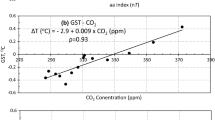Abstract
The hypothesis put forward by Svensmark and Friis-Christensen (1997), Svensmark (2007), Svensmark et al. (2017), and Stozhkov et al. (2017) assumes while completely ignoring the influence of quasi-200-year variation in TSI by ~0.4% (Shapiro et al., 2011; Egorova et al., 2018) that the increased penetrating by the galactic cosmic ray flux of the lower layers of the Earth’s atmosphere during the Grand Solar Minimum causes only an increase in cloud formation and the TSI reflected back into space. However, without calculating the changes in the global average annual energy balance between the Earth and space (Е0), the authors of the hypothesis argue that this effect will lead to a long-term negative average of the Earth’s annual energy budget and to climate cooling up to a Little Ice Age. The hypothesis also completely ignores all subsequent changes in atmospheric physical processes associated with increasing cloud coverage: the increased reflection and absorption of thermal radiation from the Earth’s surface and of solar radiation reflected from the Earth’s surface, the narrowing of atmospheric transparency windows, and the enhanced greenhouse effect. These processes compensate for the cooling. Our assessment shows that the changes in the global average annual energy balance between the Earth and space before and after a 2% increase in cloud coverage in the lower atmosphere have a difference of almost zero: E1 – E0 ≈ 0. The potential increase in cloud coverage causes virtually no variations in the global average annual energy balance between the Earth and space and has no effect on climate change (cooling).


Similar content being viewed by others
REFERENCES
Abdussamatov, H.I., Current long-term negative average annual energy balance of the Earth leads to the new Little Ice Age, Thermal Sci., 2015, vol. 19, no. 2, pp. S279–S288. https://doi.org/10.2298/TSCI140902018A
Abdussamatov, H.I., The New Little Ice Age has started, Evidence-Based Climate Science: Data Opposing CO2 Emissions as the Primary Source of Global Warming, Easterbrook, D.J., ed., Oxford: Elsevier, 2016, pp. 307–328. doi.org/https://doi.org/10.1016/B978-0-12-804588-6.00017-3
Abdussamatov, H.I., Lunnaya observatoriya dlya issledovanii klimata Zemli v epokhu glubokogo pokholodaniya (Lunar Observatory for Earth Climate Studies in the Deep Ice Age), St. Petersburg: Nauka, 2017.
Abdussamatov, H.I., Cosmic rays and clouds variations effect on the climate is insignificantly, J. Remote Sens. GIS, 2018a, vol. 7, p. 22. https://doi.org/10.4172/2469-4134-C2-013
Abdussamatov, H.I., Comparative analysis of errors in monitoring the Earth’s global energy budget by the Lunar Observatory and orbiters, Izv., Atmos. Ocean. Phys., 2018b, vol. 54, no. 9, pp. 1341–1352. https://doi.org/10.1134/S0001433818090013
Abdussamatov, H.I., Variations of cosmic rays and cloud cover have almost no influence on the climate, Solnechnaya i solnechno–zemnaya fizika-2018 (Solar and Solar–Terrestrial Physics-2018), St. Petersburg, 2018c, pp. 3–6. https://doi.org/10.31725/0552-5829-2018-3-6
Egorova, T., Schmutz, W., Rozanov, E., et al., Revised historical solar irradiance forcing, Astron. Astrophys., 2018, vol. 615, A85. https://arxiv.org/ pdf/1804.00287
Erlykin, A.D., Sloan, T., and Wofendale, A.W., A review of the relevance of the ‘CLOUD’ results and other recent observations to the possible effect of cosmic rays on the terrestrial climate, Meteorol. Atmos. Phys., 2013, vol. 121, nos. 3–4, pp. 137–143. https://doi.org/10.1007/s00703-013-0260-x
Fröhlich, C., Solar Constant. https://www.pmodwrc.ch/ en/research-development/solar-physics/tsi-composite/.
Milankovitch, M., Kanon der Erdbestrahlungen und seine Anwendung auf das Eiszeitenproblem, Belgrad: Königlich Serbische Akademie, 1941; Canon of Insolation and the Ice Age Problem (with Introduction and Biographical Essay by Nikola Pantic), Belgrade: Alven Global, 1998.
Nils-Axel, M., The approaching new Grand solar minimum and Little Ice Age climate conditions, Nat. Sci., 2015, vol. 7, pp. 510–518. https://file.scirp.org/pdf/ NS_2015111916552083.pdf.
Odyssey studies changing weather and climate on Mars, July 13, 2005. The Changing South Polar Cap of Mars: 1999–2005. MGS MOC Release no. MOC2-1151. http://www.msss.com/mars_images/moc/2005/07/13/.
Ravilious, K., Mars melt hints at solar, not human, cause for warming, scientist says, Nat. Geogr. News, 2007. http://news.nationalgeographic.com/news/2007/02/ 070228-mars-warming.html.
Shapiro, A.I., Schmutz, W., Rozanov, E., et al., A new approach to the long-term reconstruction of the solar irradiance leads to large historical solar forcing, Astron. Astrophys., 2011, vol. 529, A67. https://doi.org/10.1051/0004-6361/201016173
Sloan, T. and Wofendale, A.W., Testing the proposed causal link between cosmic rays and cloud cover, Environ. Res. Lett., 2008, vol. 3, no. 2, 024001. https://doi.org/10.1088/1748-9326/3/2/024001
Sloan, T. and Wofendale, A.W., The contribution of cosmic rays to global warming, J. Atmos. Sol.-Terr. Phys., 2011, vol. 73, no. 16, pp. 2352–2355. https://doi.org/10.1016/j.jastp.2011.07.013
Stozhkov, Y.I., Bazilevskaya, G.A., Makhmutov, V.S., et al., Cosmic rays, solar activity, and changes in the Earth’s climate, Bull. Russ. Acad. Sci.: Phys., 2017, vol. 81, no. 2, pp. 252–254.
Svensmark, H., Cosmoclimatology: A new theory emerges, Astron. Geophys., 2007, vol. 48, no. 1, pp. 1.18–1.24. https://doi.org/10.1111/j.1468-4004.2007.48118.x
Svensmark, H. and Friis-Christensen, E., Variation of cosmic ray flux and global cloud coverage—a missing link in solar–climate relationships, J. Atmos. Sol.-Terr. Phys., 1997, vol. 59, no. 11, pp. 1225–1232. https://doi.org/10.1016/S1364-6826(97)00001-1
Svensmark, H., Enghoff, M.B., Shaviv, N.J., and Svensmark, J., Increased ionization supports growth of aerosols into cloud condensation nuclei, Nat. Commun., 2017, vol. 8, no. 1, p. 2199. https://doi.org/10.1038/s41467-017-02082-2
Trenberth, K.E., Fasullo, J.T., and Kiehl, J., Earth’s global energy budget, Bull. Am. Meteorol. Soc., 2009, vol. 90, pp. 311–323. https://doi.org/10.1175/2008BAMS2634.1
Funding
This work was supported in part by the Presidium of the Russian Academy of Sciences: the project no. KP19-270 “Issues of the Origin and Evolution of the Universe Using Methods of Ground-Based Observations and Space Research.”
Author information
Authors and Affiliations
Corresponding author
Additional information
Translated by A. Kobkova
Rights and permissions
About this article
Cite this article
Abdussamatov, H.I. Earth’s Climate Does Not Depend on Variations in Cosmic Rays and Cloud Coverage. Geomagn. Aeron. 59, 935–941 (2019). https://doi.org/10.1134/S0016793219070028
Received:
Revised:
Accepted:
Published:
Issue Date:
DOI: https://doi.org/10.1134/S0016793219070028




